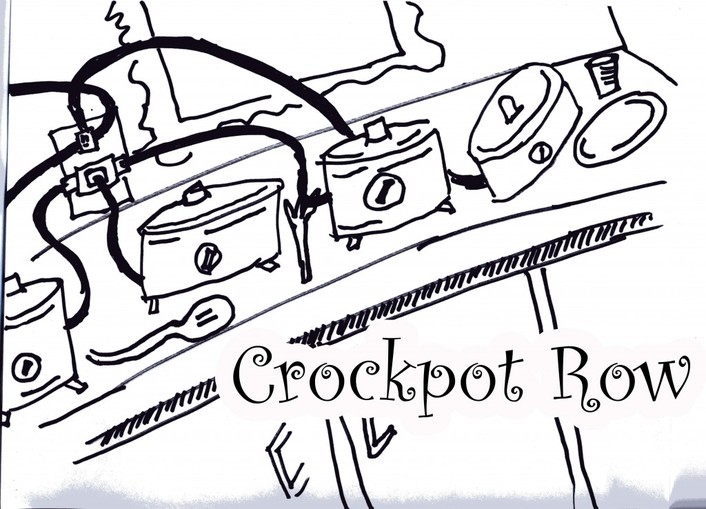Recently, I've re-entered the slow cooker world and now own two units. One is a larger capacity, basic oval cooker which I bought new and the other is a smaller round basic unit that I bought gently used. They both have removable liners. I use both of them frequently, depending the volume requirements of my recipe. I've made chili, stew, soup, ribs, stuffed cabbage, casseroles, stuffed peppers, roasts and other recipes that benefit from moist cooking (especially cheaper and tougher cuts of meat). One of the reasons I'm more receptive to slow cooking now, is the removable liners that make clean up easy and the size/shape choices that are available. Also, with the explosion of the internet, it is now VERY easy to find reviewed recipes for all kinds of foods via cooking sites, blogs and groups. Wonderful pictures of foods made by slow cooking are very tempting, and it's hard to NOT want to try them! Using a slow cooker is an energy efficient cooking method. It's also great for summertime cooking when you want to minimize heat generated by typical oven cooking. It can also free up the oven for other items.
If you are looking to replace your slow cooker, add to your collection or buy a slow cooker for the first time, it's important to do some research. You will want to choose one that you will like, will meet your needs, and does not cost you more than necessary.
Things to consider when buying a slow cooker.
(source: consumersreports.org)
Price is directly related to features. Basic slow cookers are very simple with simple on/off controls. The mechanical control offers a low/high and maybe a warm setting, but no timer. You will have to start, stop and change settings yourself. More expensive units are programmable, with built in timers. You can set the unit to turn on at a specific time, and they can automatically turn off cooking and switch to "warm". Some programmable models even offer a manual mode.
Features vary including:
- Ceramic or metal inserts. Some can be used in the oven, the cooktop or microwave. Some have nonstick linings.
- Ease of cleaning. Some liners and lids can go in the dishwasher. Touchpads are easier to wipe up vs. knobs.
- Exterior finish comes in stainless steel or colors. Stainless steel can be a bit more work to keep clean and shiny.
- Lids come in plastic and glass. Some are split lids, allowing you to open only part of the lid for checking food or for serving. Some have locking mechanisms, which are convenient when transporting foods in your slow cooker.
- Capacity options vary from 1.5 qts. to 8 qts. Capacity requirements vary depending on the family size, the size of items to be prepared (ie. whole chicken vs. a stew) In some cases, having more than one slow cooker can be a good choice. You can choose the size to fit your recipe and you can prepare two different dishes at the same time.
- Oval or round? Depends on your needs. I have both and use my larger oval one for larger items/meals.There are also slow cookers available with multiple smaller inserts, good for making different items at the same time, or for hot serving of multiple foods in a buffet situation.
- Temperature probes are available on some units and permit the unit to switch to warm when desired internal temperatures are reached.
- Additional features include: roasting racks, insulated carrying bags, cord storage.
Slow cooker safety tips
(source: consumerreports.org)
As easy as they are to use, slow cookers can pose a health risk if the food is not cooked properly. The federal Food Safety and Inspection Service recommends the following.
- Keep perishable foods refrigerated until prep time. If you cut meat and vegetables in advance, store them separately in the refrigerator. Don't let raw meat juices come in contact with other ingredients.
- Always thaw meat or poultry before putting it into the slow cooker. (I have seen posts where people put frozen meat in the slow cooker, claiming it is not a problem. Please be advised that this is not recommended by Food Safety experts as there is a bacterial risk. The slow cooker low temperatures can permit bacterial growth in frozen food as outer surfaces are thawed and inside of meat is still frozen.)
- Match the amount of food to the capacity of the slow cooker. Check your unit's owner's manual for specifics.
- Never place a cold stoneware insert into a preheated slow cooker. The temperature shock can damage the insert. Let them heat up together.
- If the power goes out during the cooking process and you are not home, discard the food even if it seems done. If you are at home, finish the cooking process by another means.
- Don't put a hot stoneware insert into the refrigerator. Sudden temperature change can lead to cracks. It will take longer for the food to reach safe temperatures. It is best to transfer leftovers into storage containers.
- Don't reheat leftovers in a slow cooker. Use conventional methods such as stove top or microwave. Heat to an internal temperature of 165 degrees Fahrenheit. After that, you can return the food to the slow cooker for transport or for serving.
http://www.consumersearch.com/slow-cookers/how-to-buy-a-slow-cooker
http://www.consumerreports.org/cro/slow-cookers/buying-guide.htm

 RSS Feed
RSS Feed
